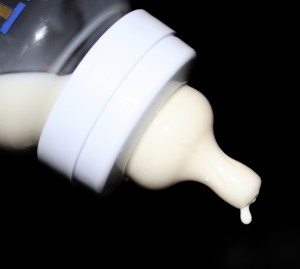Baby formula has changed and developed a lot over the past 50 years, as has the nutrition associated with it and
even the average length of time that a baby consumes it. As little as 50 years ago, it was common for parents to be discouraged from nursing and babies to be given either whole milk or a formula made at home from powdered milk. As more baby formulas became available, they became more common, but even into the 1980’s parents were told that they needed to put their baby on cow’s milk by six months.
Now of course, we have organic, hypo-allergenic, lactose-free, low iron, high iron, soy and goats’ milk formulas
in addition to the traditional cows’ milk that more people are familiar with. For babies with digestive problems or health issues, there are even baby formulas that are available from the pharmacist. These formulas are usually expensive and may help premature infants or babies with trouble gaining weight. In a few cases, babies who need this type of formula have had the cost of their formula covered by a health insurance company.
 Why are Toddler Formulas Necessary for Healthy Children?
Why are Toddler Formulas Necessary for Healthy Children?
Toddler formulas are another example of the changes that have been seen in recent years. Some babies are simply not ready for cow’s milk at the age of a year, which is when most pediatricians recommend that it be happy wheels introduced. In addition, it is possible that children who are at risk of developing food allergies may be able to lower that risk, if they wait longer to introduce those foods into their diet.
An example of that would be that a bottle-fed child who has previously shown sensitivity to milk protein or milk sugar has probably been on soy or goats’ milk formula. He or she might do well to stay on an appropriate toddler formula until at least 18 months, when their system might be mature enough to process those items.
Powder versus Concentrate versus Ready to Feed
As with most things, the easier formula is to prepare and serve, the more expensive it will be. Ready to feed formula comes in either a can that does not need to be diluted can be poured straight into a baby bottle. There are also small bottles that already have the formula and all they need is to have the nipple and ring attached. These are the most expensive and always need to be refrigerated after opening, but are easy for traveling.
Concentrate formula is not as expensive, but needs to be diluted with water. Powder formula needs to be added to water and shaken well, but per ounce is the least expensive. It’s also easy to travel with, because you can prepare a bottle with water and add formula whenever it’s needed.
The decision about how to feed your baby is a personal one. For specific recommendations, speak to your pediatrician and always be sure that formula is properly refrigerated.




